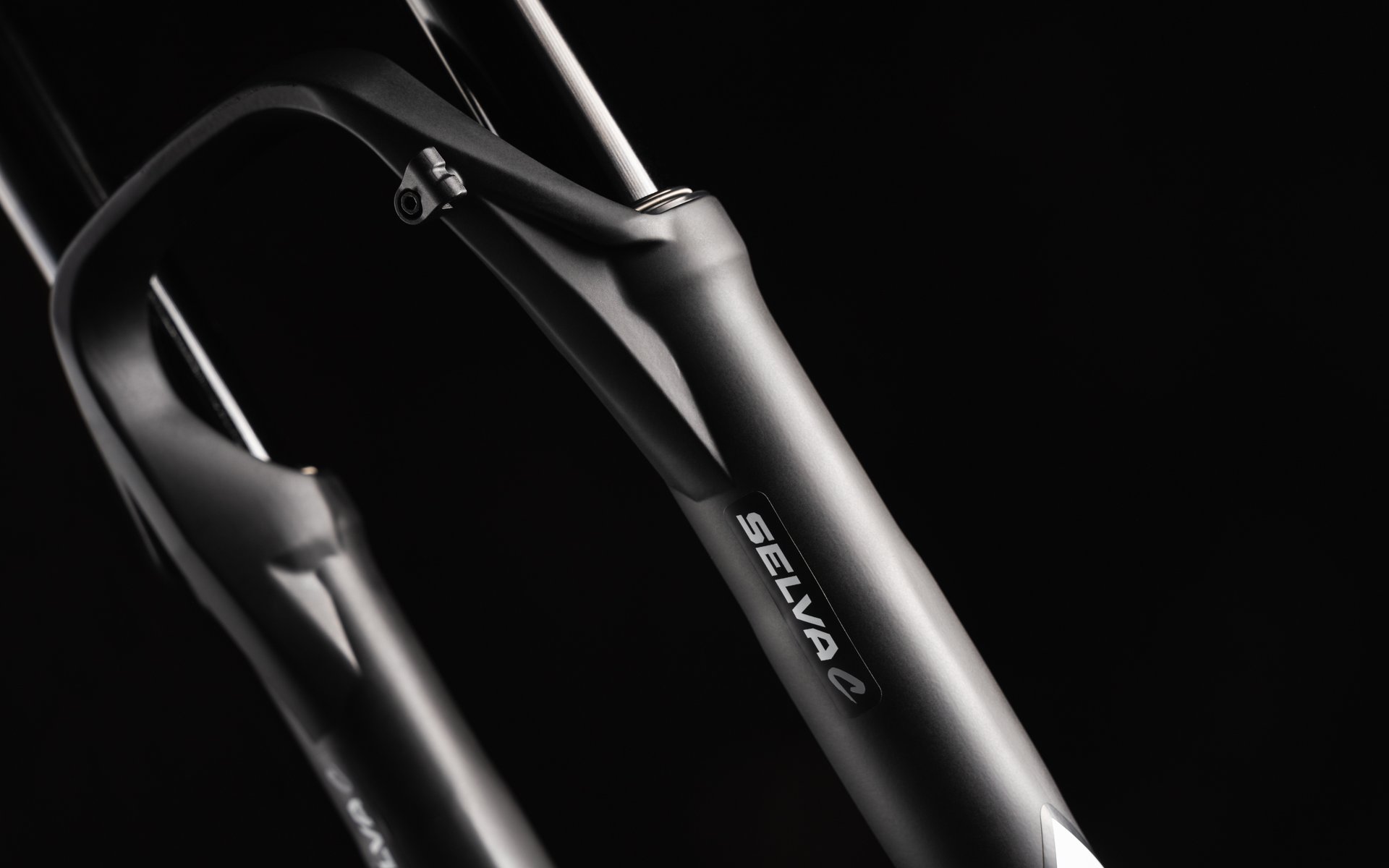
REVIEW
Formula Selva C Long-Term Review
With plenty of great forks available, each with their unique spices, picking one to put your hard-earned money toward can be a challenge. RockShox and Fox rule the roost, with each brand’s offerings readily available globally. Their mass-produced options present sensational functionality, often at a lower cost than lesser known options, leaving many riders to stick with one of the two. But there are some benefits to the boutique forks, such as Formula’s Selva range.
The Italian brand has been involved in the sport for eons with their brake offerings dating back to the late 90s. I clearly remember the blue and green Giant ATX DH2 bikes of 1999 that - at least in Australia - were fitted with Formula’s early hydraulic disc brakes. Unfortunately, my memory mainly involves the constant maintenance that friends performed over race weekends. Most hydraulic brake systems at the time were far from perfect but it seemed that the Formulas required even more patience.
Formula has continued to produce brakes, and much has changed in the 20+ years since those early experiences. But while Fox and RockShox were surging ahead in suspension, Formula took their time to dive into this part of the market. First came the 33 XC fork around 2012 and in 2015 the 35, which was the precursor to the Selva fork available today. Like their other products, much of the fork is manufactured in their Italian facilities rather than in Asia. It’s a move that may have tempered the company's growth since getting into suspension, while RockShox and Fox have exploded to become the largest MTB suspension companies.
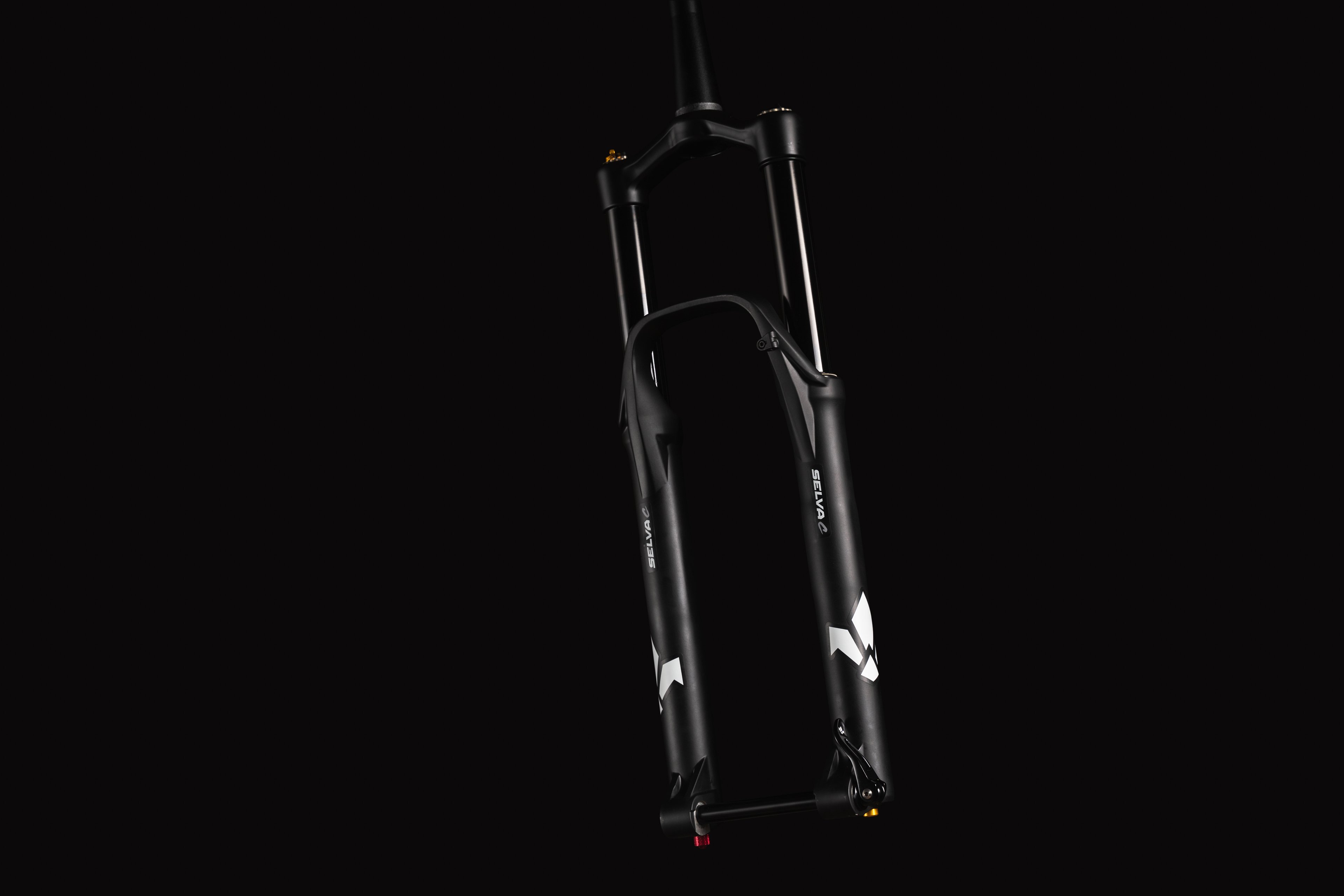
35mm stanchions, coil-sprung, 160mm travel and the distinctive damper tuning of the interchangeable C.T.S. cartridge system.
However, Formula’s small brand feel is a draw to the company for some customers who opt for their unique technology and outlook over the mass-made stuff everyone seems to have. While a suspension fork is a suspension fork to some, Formula has perhaps one of the more unique ones I’ve tried and while they can fly under the radar, there’s plenty to chat about in their range.
Highlights of the Formula Selva C:
- Air and coil-sprung options available in 27.5 or 29-inch wheel sizes.
- Coil sprung 29er tested @160mm travel
- Also available in 170mm
- Interchangeable between coil and air spring
- 35mm stanchions
- 43mm offset (29”)
- 37mm offset (27.5”)
- 220mm maximum rotor size
- 565mm Axle to Crown +/-5mm (160mm x 29)
- 550mm axle to crown +/-5mm (160mm x 27.5)
- Available with a 20mm thru-axle for those who prefer
- Weight: 2,309g (w/ hardware/axle and an uncut steerer)
- MSRP: 1,400 CAD
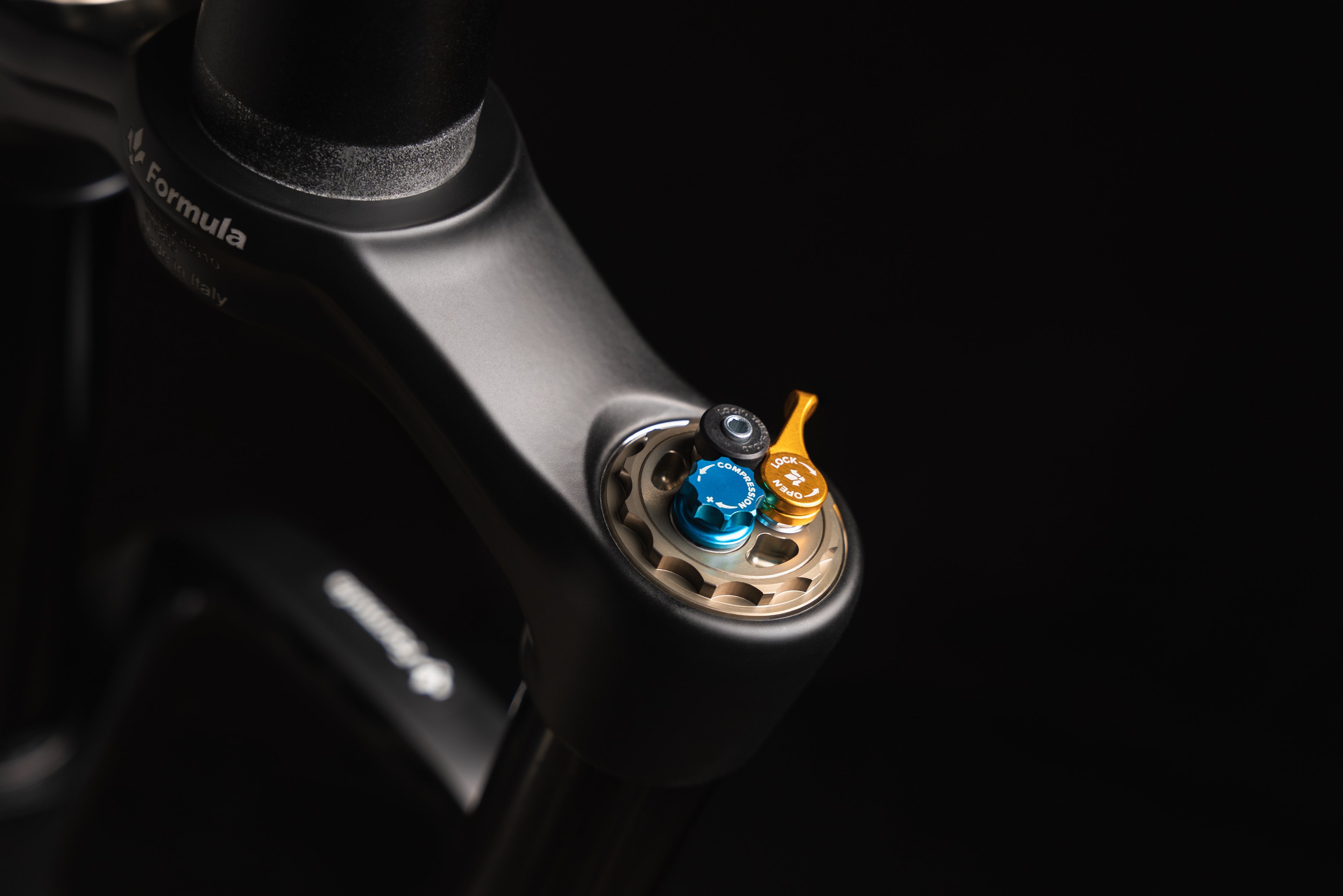
The top of Formula’s Selva forks looks quite different from the rest of the pack, with a lockout (yellow lever), the threshold for the lockout (black circle with hex key) and a compression dial laid out uniquely thanks to the different architecture of the C.T.S system.
Formula’s way of skinning the cat
C.T.S. – Compression Tuning System
There’s much to consider with Formula’s Selva suspension forks and the coil-sprung version I tested. But perhaps the fork’s most oft-discussed feature is their C.T.S. cartridge. Each fork comes stock with a blue and gold C.T.S. cartridge, offering various performance benefits on the trail. The gold C.T.S. is firmer during low-speed compressions than the blue option but mellows to maintain a stable progression through mid and high-speed compression forces. With the blue C.T.S., the compression circuit has less low-speed influence but builds more aggressively through mid and high-speed compression events.
These two provided an excellent opportunity to feel the potential differences between cartridges, thanks to their almost opposing characteristics. Each C.T.S. is fine-tuned with 12 external clicks via the blue compression dial. However, the effects of the Selva C’s compression dial differ somewhat from the competition. When adjusting compression damping, it has an impact on the entire range of the C.T.S installed. Increasing compression damping makes it firmer during hits that produce low shaft speeds, high shaft speeds, and everything in between. Other forks with a single compression dial often only affect low-speed compression, with high-speed compression set internally from the factory. But the Selva C is a top-shelf product, and comparable options from RockShox and Fox allow riders to adjust both low and high-speed compression externally. While I’ve been told that one influences the other with almost every adjustment, I still believe separate low and high-speed dials offer more flexibility within the setup.
The interchangeable C.T.S. cartridges are where things get interesting, allowing for a wide range of tunes without tearing apart shim stacks or removing the fork from the bike. Switching the C.T.S. cartridges is easy and while not advised, I swapped them trailside, carrying the alternate C.T.S. in a small ziplock bag, along with the (provided) custom tool - a small spanner and hex key - for removal of the compression dial. Removing the C.T.S. results in the oil/internals of the fork being open to contamination and doing so in a clean environment is recommended, but it’s simple enough to do trailside and made for efficient back-to-back testing.
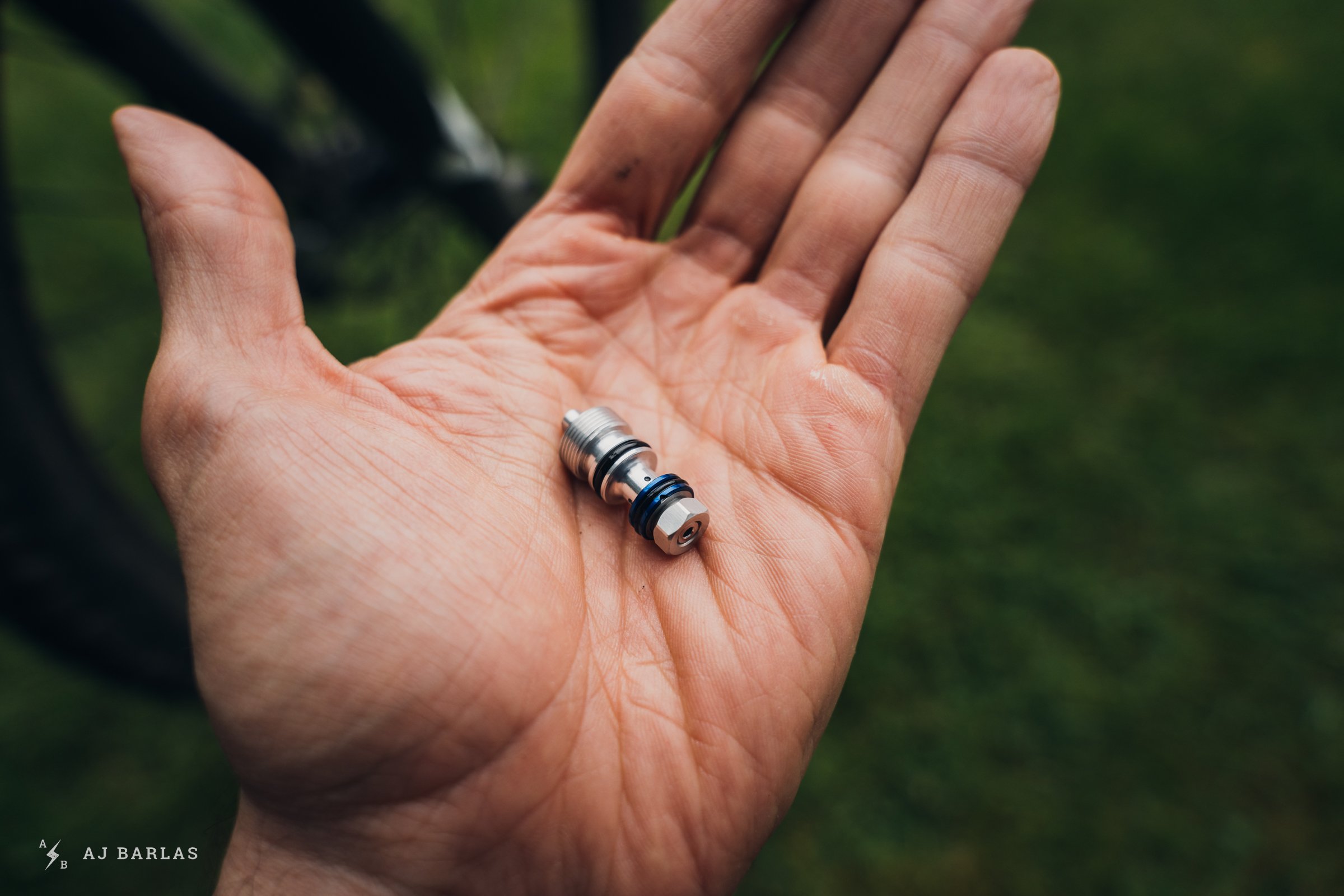
This little gizmo is Formula’s special C.T.S. cartridge. The blue-coloured ring is how Formula differentiates them from each other.
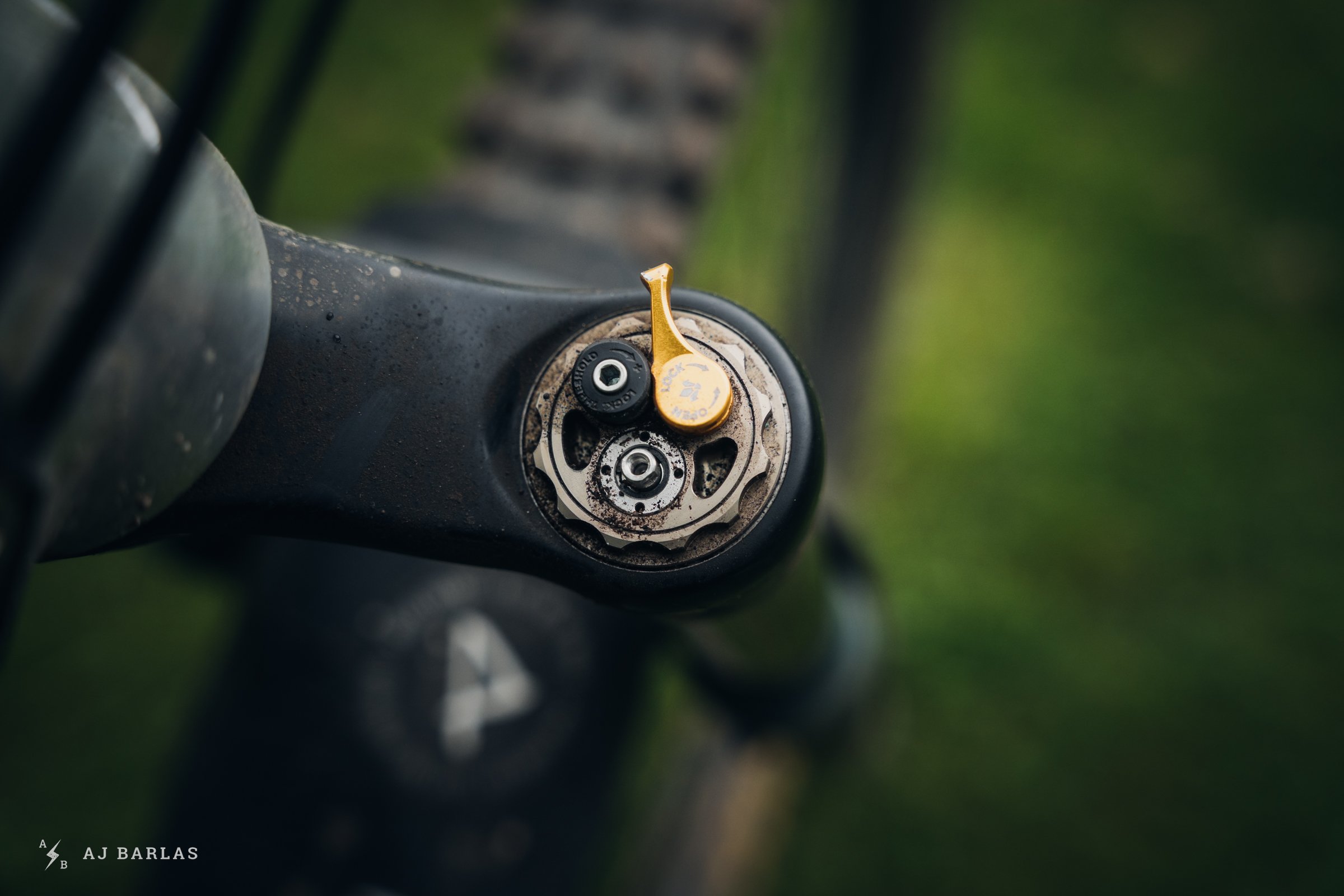
With the compression dial removed, we’re greeted with the interface that Formula’s special (included) tool fits to remove the C.T.S.
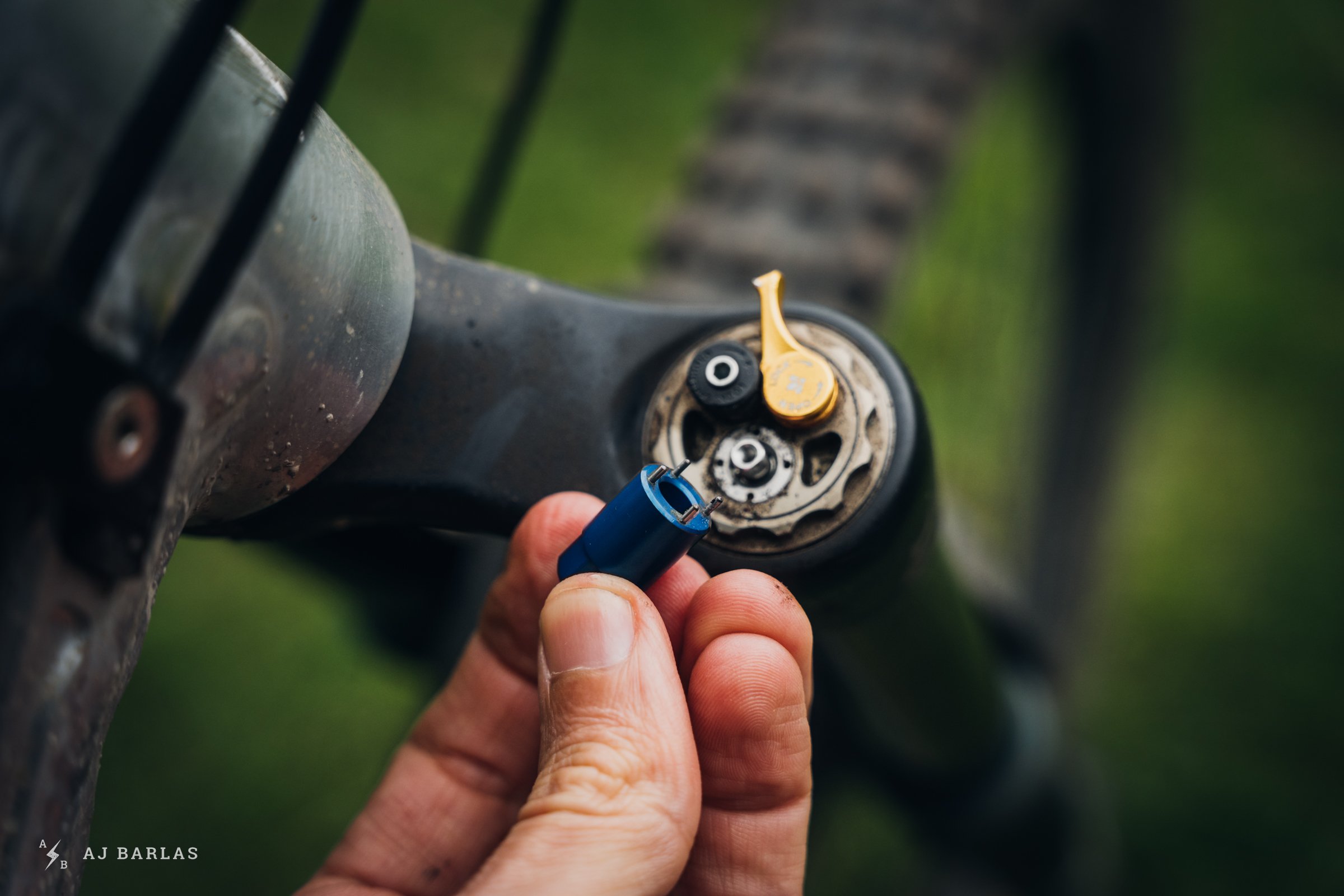
The tool is small and requires a 10mm socket or spanner to remove the C.T.S. from the fork crown.
If the stock C.T.S. cartridges don't suit, riders can purchase a different cartridge for 89.95 CAD and try another tune; Alba (Formula's Canadian distributor) will also work with customers to help them achieve the damper setup they prefer, helping cut the cost from potentially needing to purchase multiple units. Each cartridge provides a tune that more or less follows the curves of the stock blue and gold cartridges I rode but are either firmer or lighter, especially when shaft speeds increase.
The orange, green and electric blue (e-bike) C.T.S. cartridges provide more progression through mid and high-speed compressions but follow similar curves to the gold one I tested. Two options are similar to the blue C.T.S.: a silver one that provides lighter mid- and high-speed compression damping, while a red option provides a firmer mid- and high-speed tune. There are subtle differences during low-speed compression events between the blue, silver and red, likewise between the gold, orange, green and electric blue, but these are more modest than when higher shaft speeds are introduced.
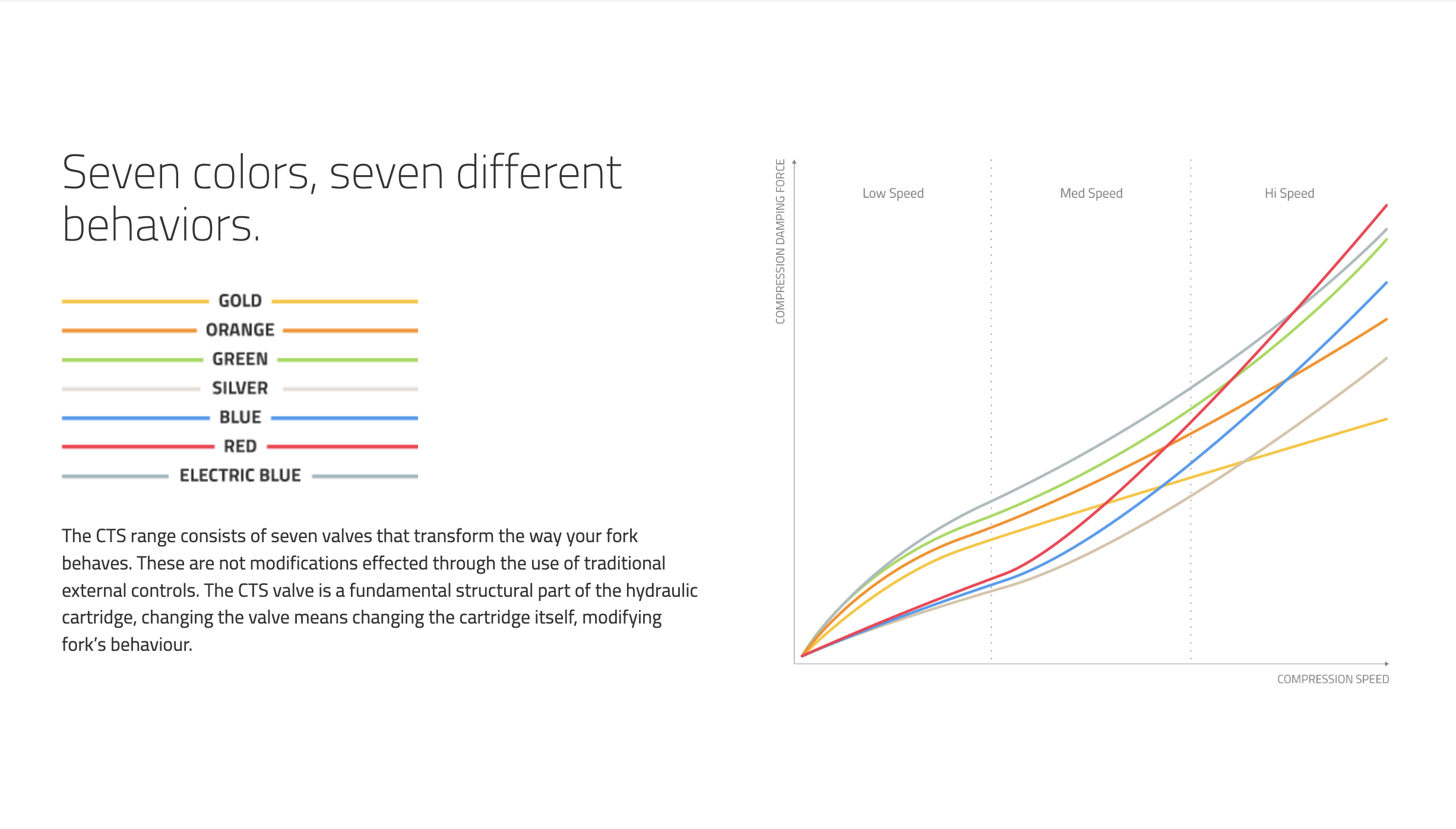
Formula’s graph shows how the different C.T.S. cartridges behave at different shaft speeds.
With the blue C.T.S. installed, the fork was light and hyperactive over terrain producing low shaft speeds but quick to firm up when encountering sharp impacts. The fork was very sensitive but could support and protect me whenever charging into features; beneficial in situations where the trail is unknown. I enjoyed the character of the fork with several clicks added to the external dial; however on longer runs hand fatigue became a problem with this C.T.S. installed, and opening the damper more allowed the fork to move excessively for my liking at lower shaft speeds.
Formula notes that the gold C.T.S. is their “closest to the industry-standard setup of an MTB fork,” and perhaps that’s why it became my go-to. While the blue C.T.S. had its moments, I preferred the heavier low-speed compression and more subtle progression through both mid and high-speed compression events of the gold C.T.S. I experienced no problems with hand fatigue using this option, and I prefer more low-speed damper control and less progression overall.
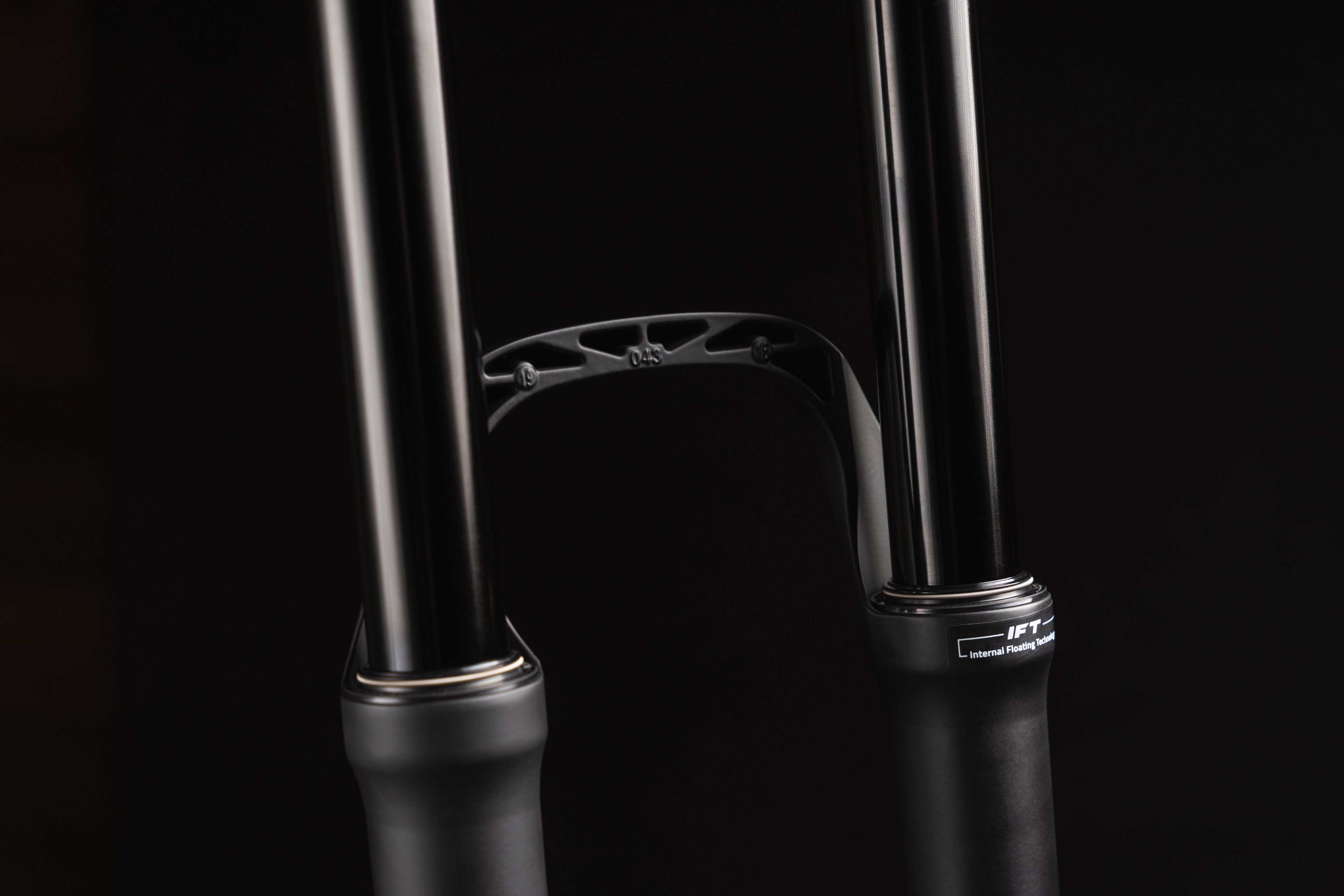
Formula’s Internal Floating Technology doesn’t differ greatly from what the competition provides but it is the smoothest fork I’ve ridden.
I.F.T. – Internal Floating Technology
Another feature of the Selva C that benefited performance was their I.F.T. As with many products, Formula isn’t immune to marketing mumbo jumbo, but this feature had a noticeable impact on the ride experience.
Formula claims their Internal Floating Technology provides a smoother operation of the fork than the competition, and after riding it, I have to agree. They claim to have tested many coatings to improve glide over each surface but found to minimize friction best, especially when the fork experiences lateral load, the better remedy was to mate the damper with the chassis. In reality, all fork dampers are ’structurally merged’ with the chassis but where I found a notable difference in the Selva C was thanks to the addition of subtle internal differences.
As I pointed out in the Selva C Teardown, Formula uses rounded edges in the seal head and bushing of the damper. These have a resounding impact on the fork’s performance, as I experienced. Where most forks would bind while encountering these lateral loads, even if only for a fraction of a second it transfers more energy to the rider, demanding more attention and effort to maintain control. The Formula Selva C moved more freely where others tended to get caught.
It may not sound like much, but it profoundly affected performance on the trail. In one particular situation, I could feel the fork acting like no other I'd previously ridden, whether coil or air, top shelf or not, stock or customized. A trail I regularly rode during testing features a winding, mid-grade descent that levels out before running another 10 meters and wrapping to the left. The corner isn’t supported at all, and exit speed is vital for the next section of the trail, which is flatter and continues through a few more mild bends. But in addition to nailing the speed and approach, an extra challenge makes it difficult to exit well.
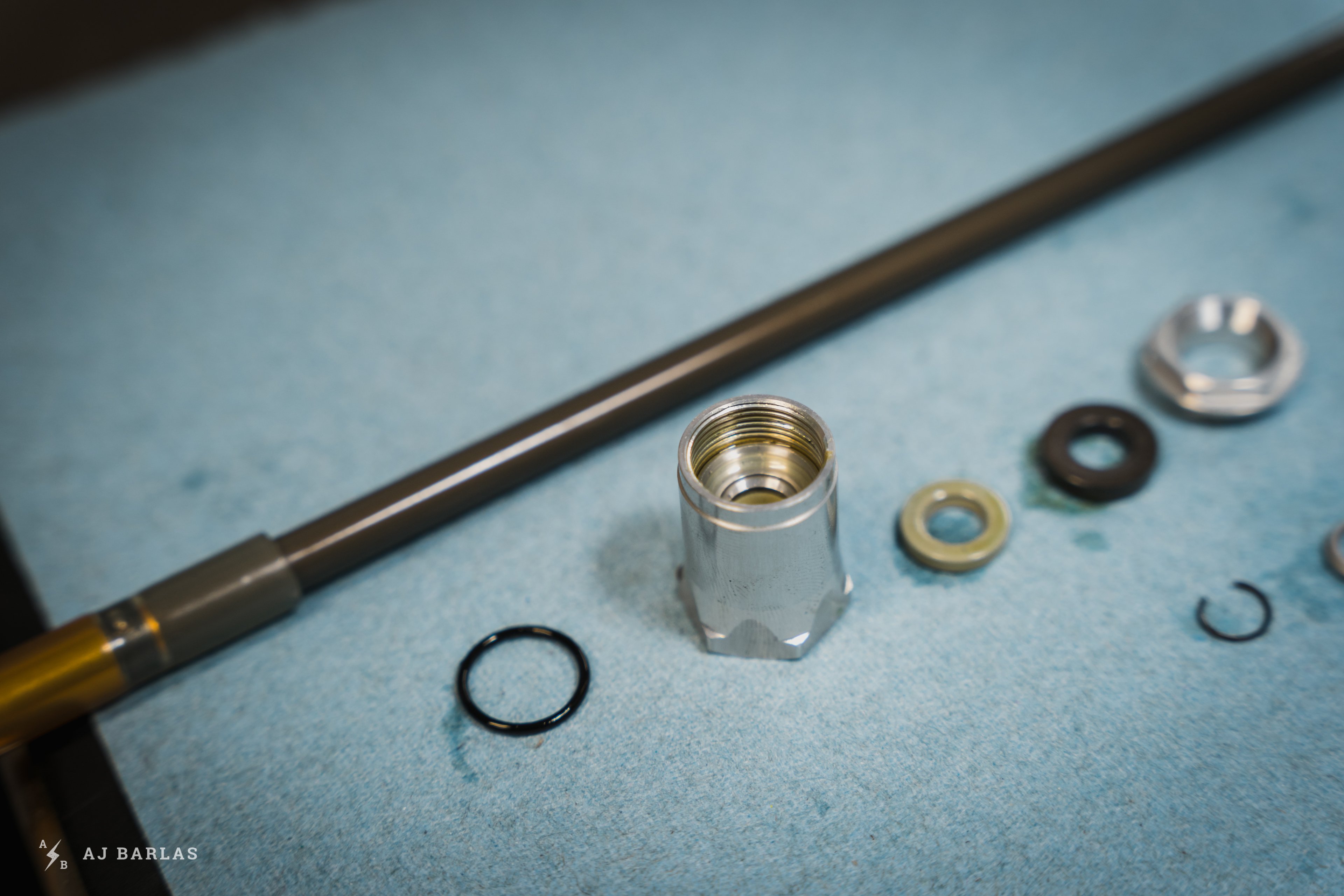
The rounded edges in the seal head and on the bushings (next to it, to the right, above) were what made a notable difference on the trail.
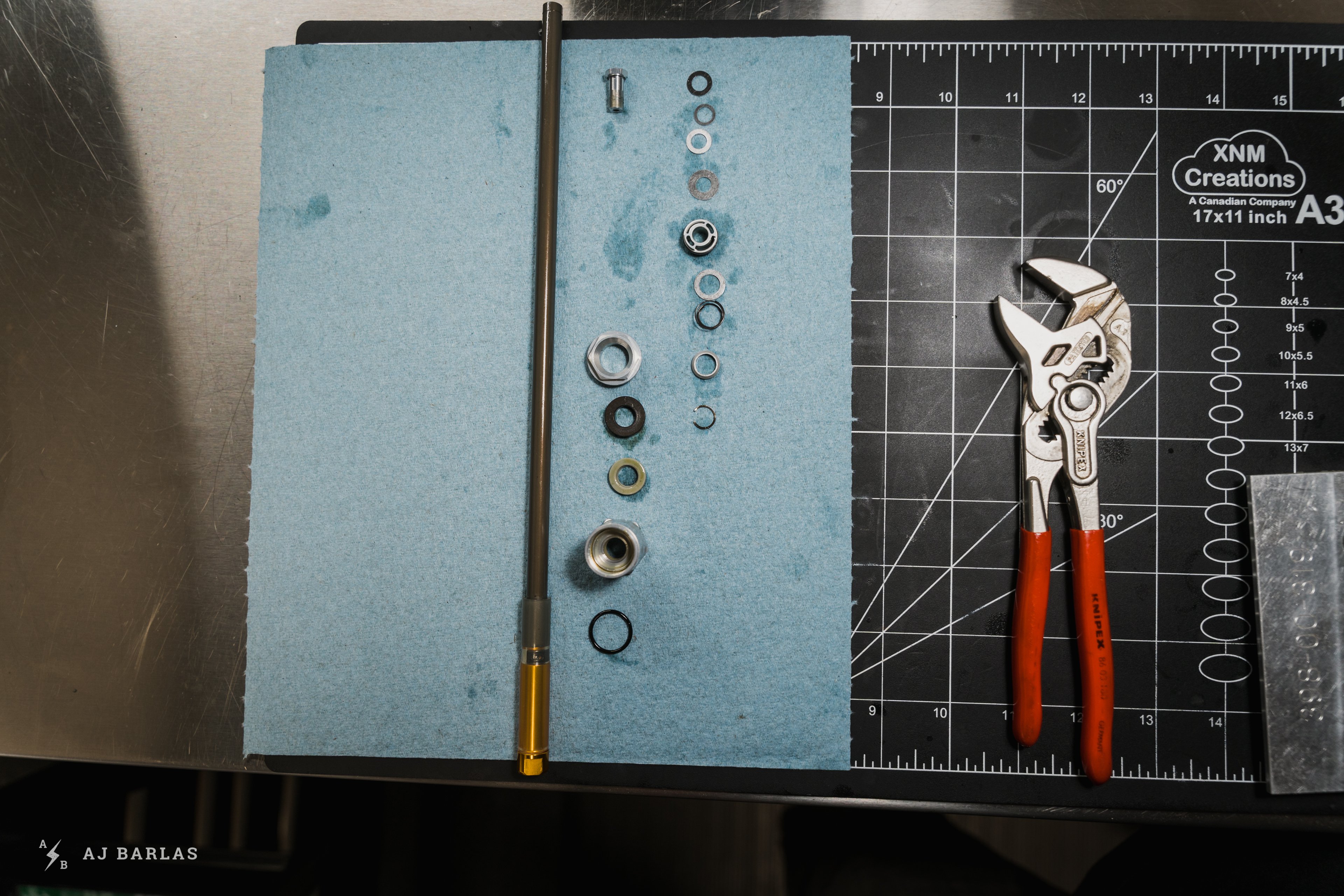
When performing the teardown we applied light flex to the damper shaft and were able to effortlessly compress it. A competitor's damper caught and stopped the compression.
The corner features a series of randomly placed, firmly planted baby-head rocks that can toss the front wheel about and the best line through forces you to take them on. It’s not a particularly difficult piece of trail, but completing it well and carrying speed into the next section doesn’t go unnoticed. On my first run through the corner with the Formula Selva C, I subconsciously prepared as I would have with my previous setup. Leaving the corner, I was in disbelief and jammed my brakes, dismounted and ran back to the corner.
After inspecting the corner for possible changes, I ran back to the top of the section to ride it again. On the second run, the same thing happened; it was the smoothest the corner had ever felt, and the bike glided out of it into the following section. My hands felt little feedback; no jostling to control the direction of the front wheel, no jarring movements; it felt effortless. I was on some sort of magic carpet through the section.
It left me puzzling about what was going on; what was this dark sorcery? How could the Selva C have such a drastically different feel when I banked the bike through this bumpy flat corner? I believe the effort Formula took with their Internal Floating Technology and the use of rounded edges in the seal head and bushings play a huge role in these characteristics.
The Selva C amazed me during every ride on this section of trail. Swapping back to my other coil fork, the Öhlins R.X.F. 36, only showed the stark difference in this scenario. While still a massive fan of the Öhlins m.2 Coil, the Selva C had it beat when it came to smoothing out the trail where lateral loads are applied. The fork felt smooth everywhere too but it was moments like the one above that clearly highlighted the benefits of a few subtle changes in the Selva C's construction.
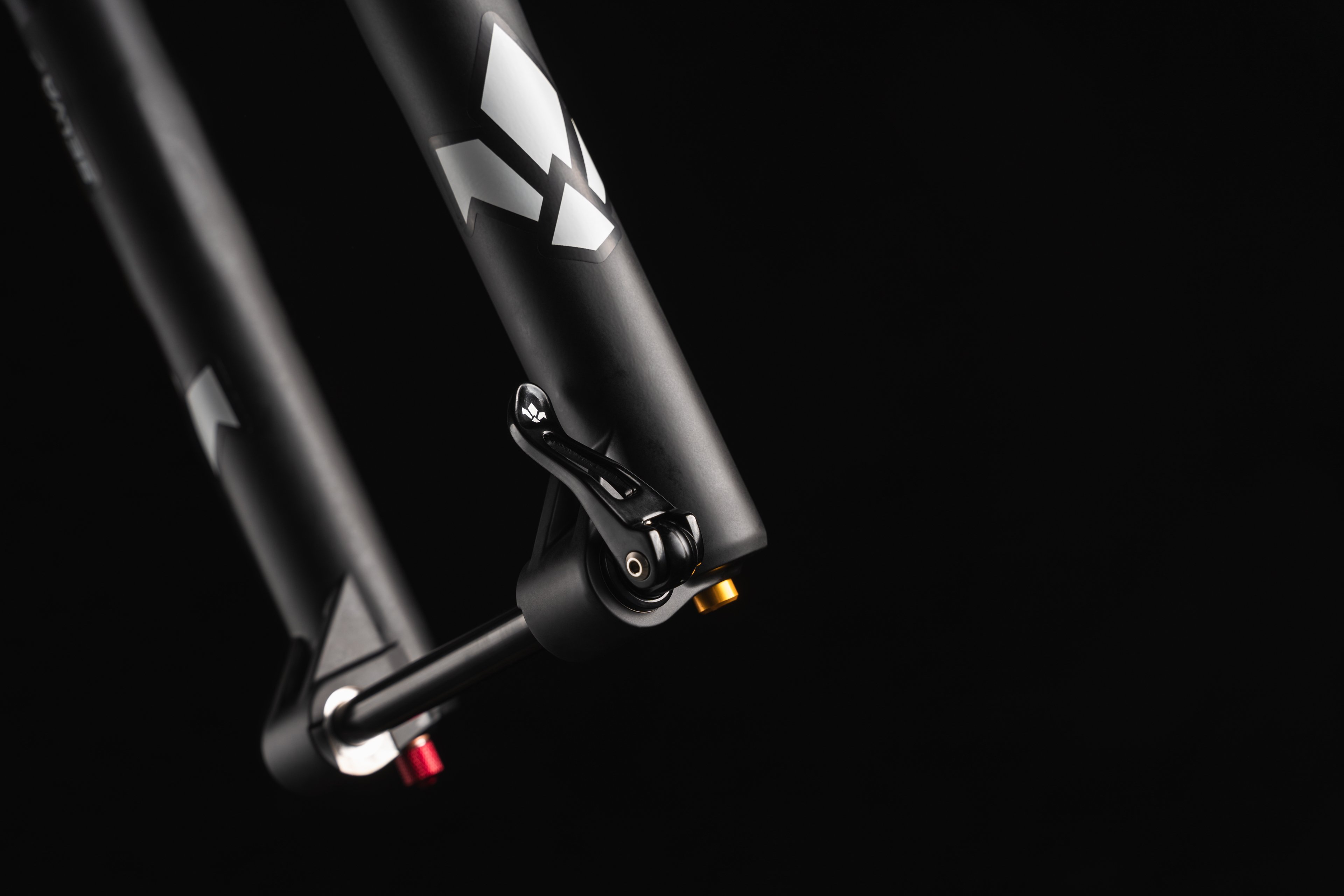
The quick-release lever is a clever system providing the ability to run the lever, or remove it and have a typical bolt-in axle.
I.L.S. – Integrated Locking System & HEX – Hexagon Design
Formula's I.L.S. is a clever axle system allowing users to decide whether they want a quick release or bolt-on setup without purchasing a different axle. A quick-release lever integrates with a 5mm hex that securely sits in the front axle. A firm yank on the lever removes it from the axle altogether. Riders who prefer having the quick-release lever can reposition it easily for trouble-free stowage while riding. I opted to use the fork without the lever, reaching for a hex key whenever removing the wheel, which was only necessary when working on the bike at home.
The Hexagon Design refers to the structure used in the lowers, which Formula claim offers “the perfect balance point between stiffness and flex.” The fork feels comfortable on the trail, but I did find that fore-and-aft flex was more than what I am accustomed to with the Öhlins. It felt similar to the amount of flex I have felt with Fox’s popular 36 models, which I don’t find as rigid at the crown as others. This is neither good nor bad, but it’s a difference worth mentioning.
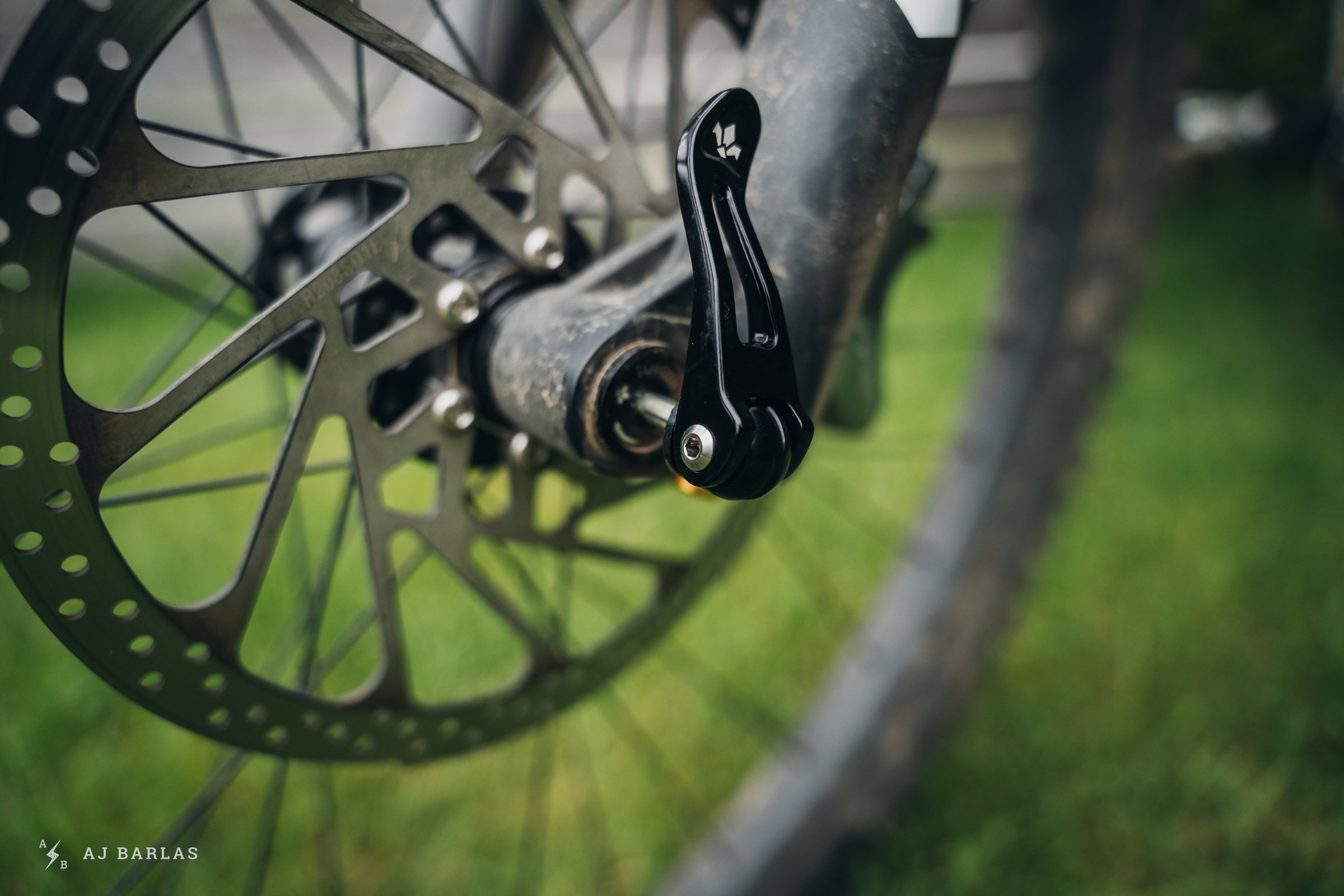
The quick-release lever is held tightly in place and was the first question I fired to Ben at Alba after mounting the fork to my bike.
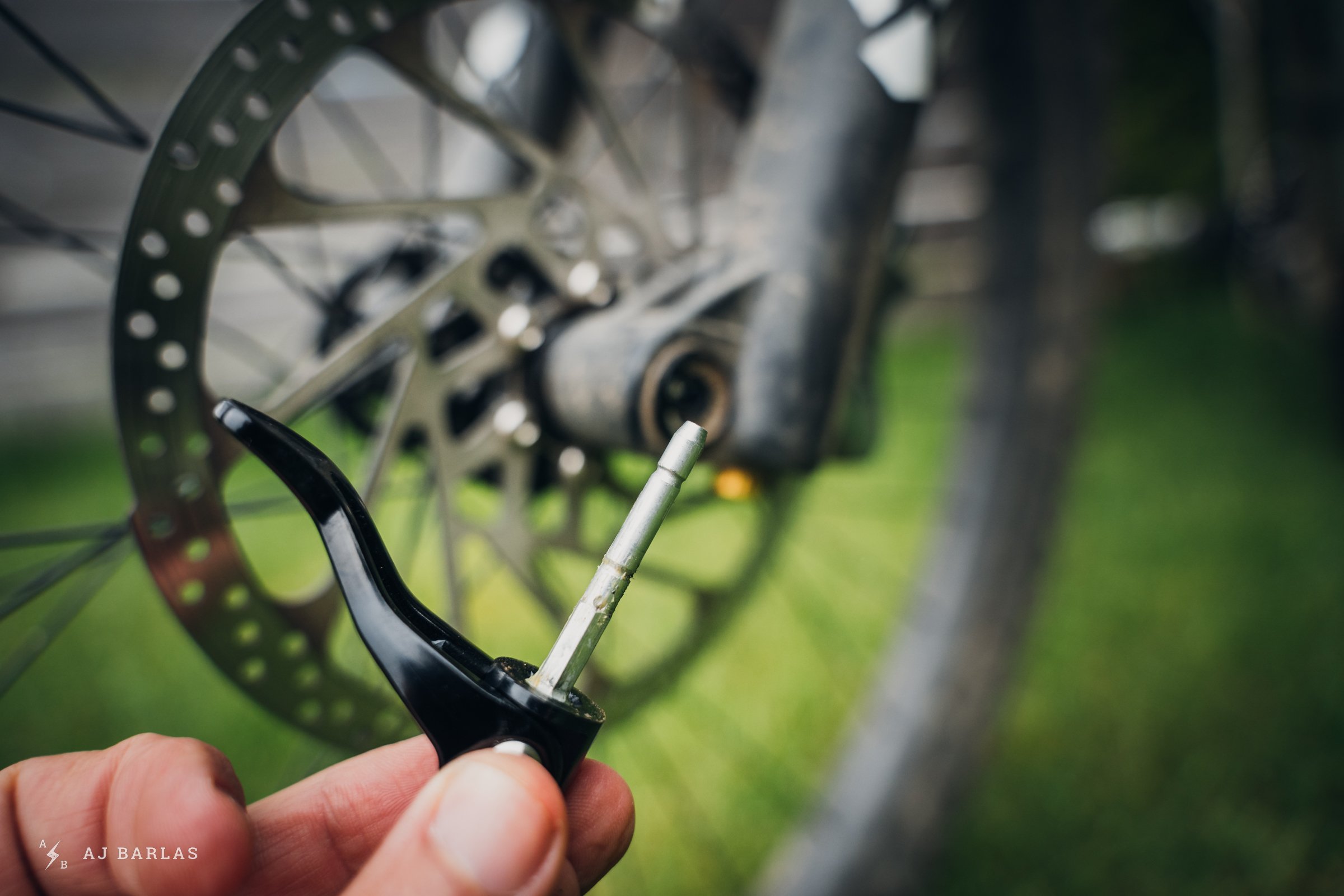
It required a firm yank, firmer than I thought safe before confirming with Alba, to remove it. It could then be rotated to the safest position, or left out altogether.
Can It Be Improved?
While the Formula Selva C does an incredible job of smoothing the trail, there were a couple of items that I wasn’t too fond of. I’m nitpicking, but they may interest riders with similar inclinations.
The lack of ability to separately refine the low and high-speed compression settings externally wasn’t something I got along with. The C.T.S. system is excellent, offering varied characteristics with a simple swap. Fine-tuning the compression with the external dial is a breeze when you find a C.T.S. that suits you. But if you need to fine tune the L.S.C. while minimizing impact to the H.S.C., for example, you’re out of luck. If I was able to do so, I may have ended up with the blue C.T.S. as a favourite, but backed off the H.S.C. a touch to compensate. Or I might like to touch up the L.S.C. of the gold C.T.S., making it more linear again.
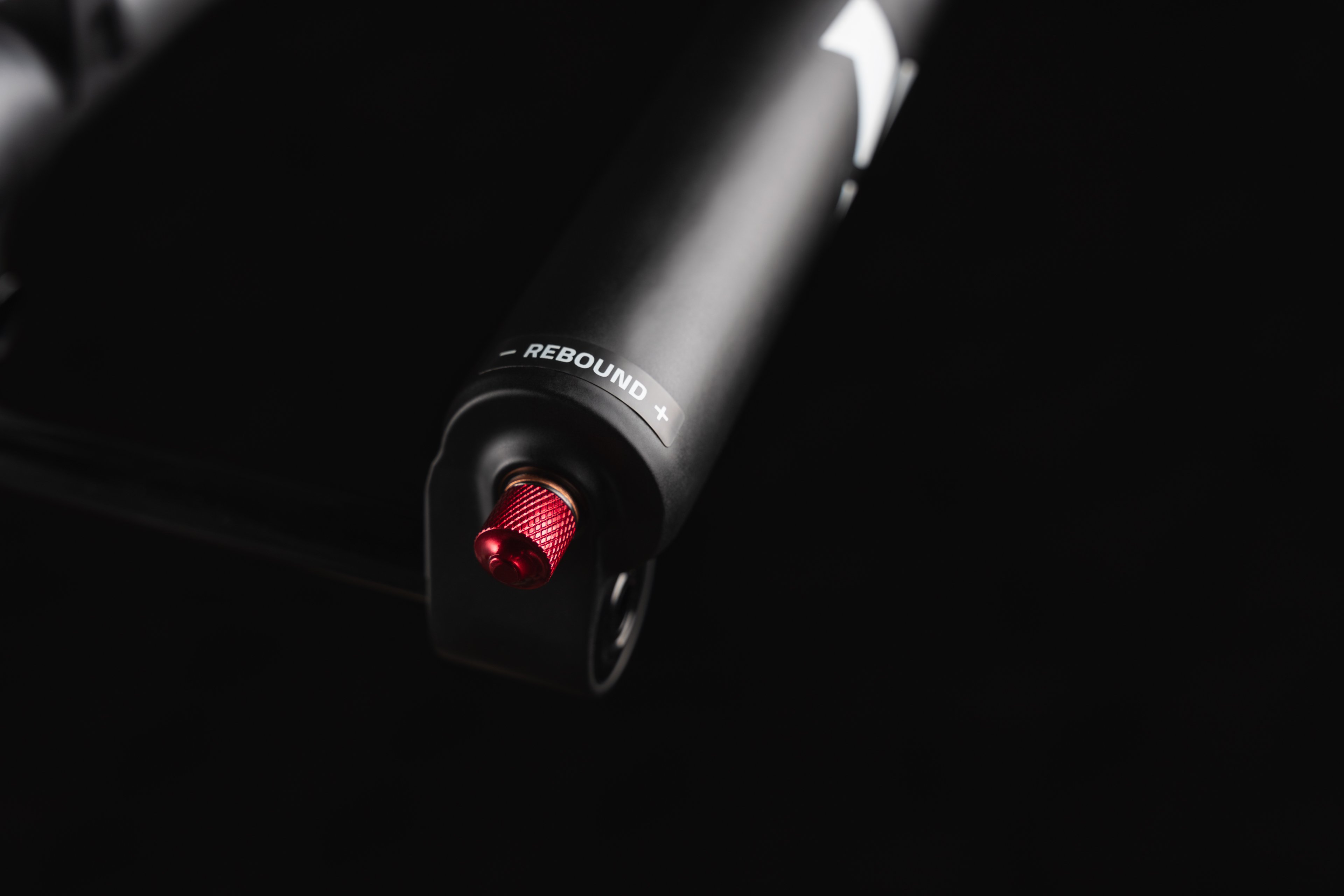
The rebound dial's detents in my fork weren’t the clearest when setting the return speed of the damper. It would be nice to see this improved if it wasn’t a one-off with my fork.
Moving to the bottom of the fork, I found the detents of the rebound dial vague, making it difficult to tune and know where I was in the range. It could be a one-off experience with my fork, and it isn’t the end of the world, but it’s something that riders should be aware of. There’s a high-quality feel to satisfyingly pronounced clicks when adjusting dials; on my Selva C that wasn’t the case.
Lastly, it would be nice to see the chassis stiffened up for aggressive riding. Bike parks days, or hitting rough compressions at speed with the Formula Selva C showed the fork to be a touch nervous where others deal with these situations better. A fork with this travel should be expected to encounter bike parks and rough riding, and while possible on the current chassis, it could be better.
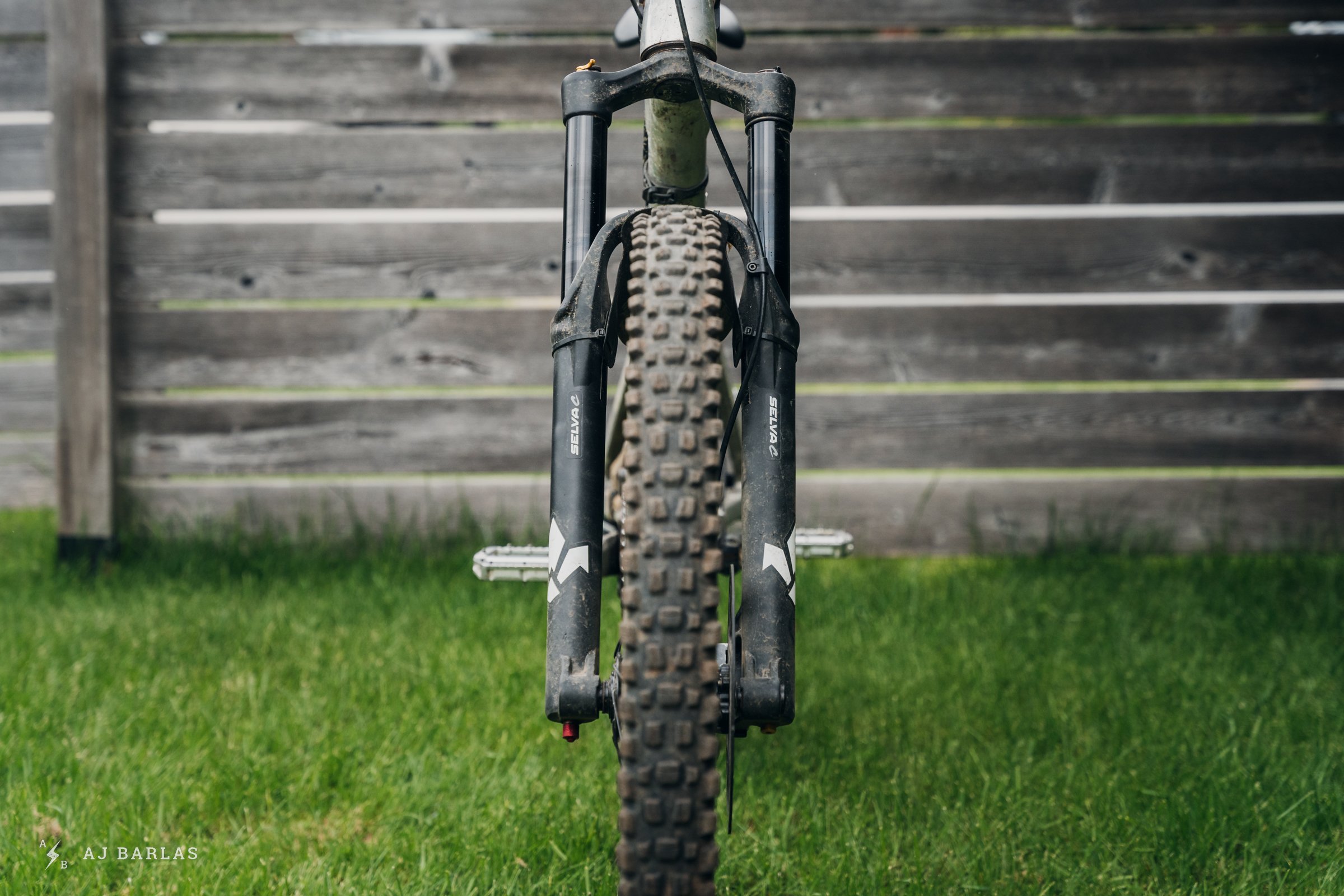
Responsive to the mildest feedback but supportive under big hits. The Selva C is the smoothest coil-sprung fork I’ve ridden to date, yet it's not perfect.
Verdict
Sometimes I find myself wishing I could have features from various forks and melt them into what would be my ultimate fork. Often, none of them are far away from that dream and other times, I’m surprised when things are even better. I didn’t know what to expect when I tested the Formula Selva C, and I was shocked to discover how smooth it was during general trail riding duties in a wide range of situations. It feels sensational.
There’s also something satisfying about Formula building their forks in their own Italian facilities. The amount of work to design, test, then manufacture the Selva forks is no different from the competition. But it’s impressive to know they do it in-house and that the result is equal to the competition while doing some things better—all for a similar cost to the top offering from their biggest competitors.
More information on the Formula Selva C is available on their website.
Age: 39
Height: 191cm/6’3"
Weight: 73kg/160lbs
Ape Index: 1.037
Inseam: 32”
Trail on Repeat: Changes as often as my mood.
Current Regular: Every test product spends time on Entrail


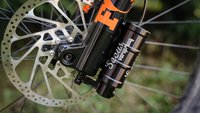
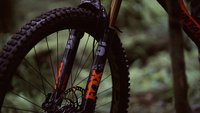







Comments
Velocipedestrian
1 year, 9 months ago
Nice to see an AJ review again. Good details and crisp pictures, welcome back.
Reply
fartymarty
1 year, 9 months ago
Yeah welcome back. Sounds like an interesting fork - maybe a double crown version would tick the stiffness box...
Reply
AJ Barlas
1 year, 9 months ago
Cheers guys.
Reply
danithemechanic
1 year, 9 months ago
As i got this fork myself (used) i must point out that Formula did some major changes in the CSU and wipers design lately wich can be both seen on your fork AJ.
This because the old stanchions (identified by the crown with the lateral dimples) combined with the old wipers (Formula marking on them) have a bad wear problem, no matter how much you clean them.
But they didn't tell anyone! neither they differ the newer wipers from the old with a different spare number.
My advice if you're considering any Selva model for purchase, new or used, is to check for wich model you're getting and for stanchion wear. Hold them against the light because sometimes it's subtle.
Also when purchasing wipers, double check the version, the new ones can really help on an older fork.
Oh and the quick release, it's just a lever added to a bolt on axle.
Reply
Wouter Bekker
1 year, 9 months ago
What did they change about the CSU? Pls let it be more stiffness for less fore-aft flex.
Reply
danithemechanic
1 year, 9 months ago
Who knows! they never officially said anything about the change.
Word is that the new stanchions are made in china opposed to the prior made in Italy and the coating should last longer than three months.
Reply
Jakub Gábriš
1 year, 9 months ago
You must be the only one with that problem it seems.
Reply
danithemechanic
1 year, 9 months ago
Nope, every person i know that has one or has ridden one, sponsored riders too, all had discoloured stanchions.
To the point some tried to warn me before my buy, but they thought it ended with the previous generation (non boost).
Maybe it's not felt as a big issue because the whole csu should cost around 180€ if i recall right, surely they're not 3-400$ like Fox.
I think Formula has such a small production, they just don't really care. Not too many people are going to buy these forks anyway, and they're oem on like three obscure bike models.
Just like changing wipers without changing serial number or warning anyone, suspension centers as well.
Reply
Spooky817
1 year, 9 months ago
Read the lower comments, a lot of very happy Selva owners, myself included. I am aware of the issue you mention with the seals, however it is not all the old CSU and seals as you mention, it was merely a later batch of seals. The main thing is, if you have a Selva or buy one and you don’t have the new seals, upgrade them to new seals to ensure your seals are definitely not from the bad batch and you’ll be fine. I know plenty of ‘old’ Selva’s that are perfectly fine, including one I have. Also, don’t take the foam rings out to soak them in oil, you’ll never get them in there perfectly square again, rather soak them with fresh oil while still in the fork. This was a very handy tip I learned recently.
Nikita Morozov
1 year, 9 months ago
Yeah, the foam ring replacement was a challenge. I did it three times already =))
I assume the foam rings should not be perfectly aligned as they wouldn’t be torn by the stanchion anyway.
But the most challenging s**t is the spring-like clip that holds the air spring inside the stanchion — OMG, the first attempt took me at least 30 minutes. I still hate it =)) Why the hell they refused to use a c-clip, why?
Nikita Morozov
1 year, 9 months ago
I’ll add a few things I learned from Formula guys.
There’s a serial number on the back of the crown. Formula guys are super helpful and responsive on the Instagram chat, so you can ask them what MY is the fork you are planning to purchase. Mine is MK1 2020, no problem with anodising, CSU. You can even ask the for a part number for spares, so you’ll be able to buy them from EU online shops. MK2 2Air kit is different to MK1 and I assume that’s it’s not the only part that is different, so ask them first.
Also it should be noted, that 29 S and R models with 120-160 mm of travel are MK1, 29 Extended 170-180 mm are MK2 models.
And MK2 170 mm has the same axle to crown as 170 mm Lyrik, 1 cm higher than the MK1. But as you get a higher riding height, that 1 cm on the MK1 doesn’t make any difference in the real world.
Reply
danithemechanic
1 year, 9 months ago
Thanks for the info, i'll try to find out my model year then.
I still think they should have had a press release on the updates between the generations, in the end it's in their interest advertising an upgrade. I really don't understand their way of dealing with this.
Reply
Nikita Morozov
1 year, 9 months ago
It's funny, but they had a press release a year before they silently updated the Selva. Actually, I was asking them about the axle to crown height, and they told me that the MK2 version has solved this problem. I asked them if they had any photos to help me find the MK2 model, but they still don't have them even on their website and in Instagram =))
In this article you can see the CSU are different (MK2) to those images on their website. That's the only visual difference. Internals are the same apart from different length for the Extended version.
Reply
Spooky817
1 year, 9 months ago
Hi Nikita, the foam ring is not so much a challenge, more that you just need to know that when you want to replenish the lubricatiuon by soaking it, you can't remove it and soak it and re-fit it, much more that you have to leave it in place and soak it with a syringe instead. This should be in the owners manual and unless you know it, you could do it wrong and risk the foam ring rolling and not providing the lubrication that it should which won't happen if soaked correctly, but you need to know this.
Also, correction to the above, all extended 29er forks are 160 - 170mm travel, not 180mm!
Reply
Nikita Morozov
1 year, 9 months ago
Yes, my mistake, 160-170 mm travel.
When. you are talking about replenish the foam rings, you mean replacing them with new and actually replenishing them using syringe? This way it should work, but I reuse them after cleaning them with alcohol as they do not worn cause I'm serious about the schedule )
Reply
Spooky817
1 year, 9 months ago
After installation in the fork the foam ring is soaked with oil. This lubricates the stanchions. This oil in the foam ring needs to be topped up from time to time. To do this, leave the foam ring in the fork and just soak with oil using a syringe, do not remove the foam ring to soak and insert back into the fork again is what I was tryng to explain. If you remove them and re-insert them, you risk them not being fullly in the groove properly and then they can twist. I hope this makes sense.
Reply
Wouter Bekker
1 year, 9 months ago
Very interesting and a great coincidence because I literally started asking around about this fork on the internet 2 days ago as I'm seriously considering going coil and the Selva is my preferred contender so far.
Few questions which perhaps I missed:
- is there any end stroke ramp up like in the Z1 coil due to trapped air?
- how did the fork deal with big compressions?
- did you feel the rebound hindered pop? (read elsewhere it's sluggish)
- do you happen to know if the ohlins springs fit this fork as well? (read it somewhere)
- I'm 86kg without kit. Would you say this fork is too flexy for enduro / bikepark? The Lyrik I ride @ 160 feels ok but I'd rather gain than lose chassis stiffness. Especially fore-aft.
Reply
Nikita Morozov
1 year, 9 months ago
Me and my friends have three Selva S and R.
The article actually miss the fact, that the Red, Green and Electric Blue CTS act as hydraulic bottom-out by the design.
CTS mentioned above will eat any drop, compression you will ever encounter. I have all the seven CTS, and the Green and Blue are superb blends of chatter removers and bottom-out resistors).
If you need the midstroke support, go with the Green. If you’d like to have the half of the travel super smooth — go with the Blue.
Electric Blue is the most interesting CTS. It has a huge support in the mid travel, doesn’t dive, but still eats chatter. It’s like if you close LSC and HSC on the Lyrik, add 4 tokens. But it works like a charm, and the Lyrik with these settings will destroy your hands in a minute.
Rebound is fine with quite wide range. Some years ago there were some reports, but it’s fine.
I don’t feel any unnecessary flex weighting 113 kg w/o gear on my Turbo Levo on MK1 Selva S, so I assume that you wouldn’t feel it too. You will simply forget that it’s there, so you you’ll stop noticing any flex.
As for the comparison with any sramshox or fox — Selva in any of it’s versions is a far cry in terms of performance as long as you what to completely retune it for each CTS.
Reply
olaa
1 year, 9 months ago
Really happy with my Selva R, it's a dream on the rooty off-camber trails that we have a ton of where i live. But it definitely feels more like a trail/light enduro fork than a heavy hitting race fork, and the weight is in that ballpark as well.
Well excited to try the double crown version when that finally shows up!
Reply
Nikita Morozov
1 year, 9 months ago
Have you tried the Green or Electronic Blue CTS. They convert Selva into a DH fork in terms of performance. The Red CTS is interesting too, but i found that it performs at it’s best when it’s wet and the fork sits much higher under braking.
Reply
olaa
1 year, 9 months ago
No, i have not done that yet. I have been the most interested in the red for harder charging, and the orange for the slow janky stuff. My Selva is on my hardtail at the moment, but it will be tried on the FS at some time during the season. That should call for some experimenting with other cts.
Have you had to adapt air pressure a lot when changing cts?
Reply
Nikita Morozov
1 year, 9 months ago
Yes, I play with the air pressure within 10-12 psi range.
But the rebound settings can differ much more dramatically. For instance, I run my rebound 1.5 click from closed on Blue, but my friend is a bit lighter and runs the rebound half the way open ob the Electric Blue and his settings work for me perfectly. Before he had settled on the final setup for the Electric Blue, I tried it for a day and wasn’t impressed, but now it’s a kind of revelation, so I’m waiting for mine to arrive)
Reply
olaa
1 year, 9 months ago
Cheers mate! Good input, i'll make sure to have an open mind when changing the cts :)
Reply
Nikita Morozov
1 year, 9 months ago
At least you should try the Green CTS just to get the idea of the maximum performance (race-like, I guess).
The Silver CTS, at the side of the spectrum, is useless at least for me — it’s super plush with almost no bottom-out resistance.
vhdh666
1 year, 4 months ago
you seem to be very experienced with these forks, therefore my question: I've tested a Selva 5 or 6 years ago. It had this hissing sound when compressing. It annoyed me. Does the new one have that too? Thanks!
Reply
Sethimus
1 year, 2 months ago
it does, but not as pronounced as my ext storia, that thing is LOUD
Ryan Walters
1 year, 9 months ago
Man, this C.T.S. system is really interesting. Would love to try one of these, but I worry what a 170mm travel, 35mm stanchion fork is going to feel like under my weight.
Is that $1500 CAD. price correct? Seems low-ish for a boutique item like this.
Reply
roil
1 year, 9 months ago
People have been riding hard on 170 & 180 lyriks for years. Stanchion diameter is not the weak point in single crown forks.
Reply
Graham Driedger
1 year, 9 months ago
Sure they have, but the stiffer chassis of a 38mm stanchion fork is very noticeable compared to a 35mm chassis.
Reply
Velocipedestrian
1 year, 9 months ago
Crown depth has been sacrificed at the alter of weight and A-C height.
Reply
Wouter Bekker
1 year, 9 months ago
You think that's why it's more flexy? Any idea if the recent CSU change made a difference?
Reply
Jakub Gábriš
1 year, 9 months ago
New csu was mostly for shorter offset than what they originally came up with, and if you have to design a new one, you might as well change other stuff not just the offset.
Velocipedestrian
1 year, 9 months ago
I won't claim knowledge of the reason for flex, but I do think these (not just Formula, RS and Fox definitely) shallow crowns are an obvious fulcrum.
SilentG
1 year, 9 months ago
I'm not sure Formula has a US distributor.
I had really good luck/experience with Alba on a Formula Mod shock as I couldn't find a great source for them in the US and will keep using them for Formula stuff as I have the Mod, Selva, and Cura4 brakes at this point.
There is always German online bike shops as well.
Nice to see a Selva review, bit of a sleeper fork in terms of attention but really stellar. The the flexibility of options, while a blessing and a curse at times, is pretty hard to beat.
Reply
Wouter Bekker
1 year, 9 months ago
If only it had a SC bigger brother as well
Reply
Heinous
1 year, 9 months ago
How do you find the mod? Any other coils you’ve ridden a lot you’d compare it to?
Reply
Timer
1 year, 9 months ago
It sounds like this fork is the opposite of the Durolux tested recently? Coil, softer chassis, very wide range of damper adjustments. Better for light riders and sensible pace, worse for heavy lads smashing into stuff at high speed.
Reply
Kos
1 year, 9 months ago
Really appealing fork.
US distributor? I've done poorly with my Google-fu in this regard.
Reply
SilentG
1 year, 9 months ago
This comment has been removed.
Carlos Matutes
1 year, 4 months ago
Sorry to bring back an old discussion, but Bicycle Technologies, Inc. (BTI) is the US distributor. As long as your local shop is a BTI dealer you should be able to order from them.
Reply
rithisha juiq
1 year, 9 months ago
I should exchange mine for this one.
Reply
Please log in to leave a comment.